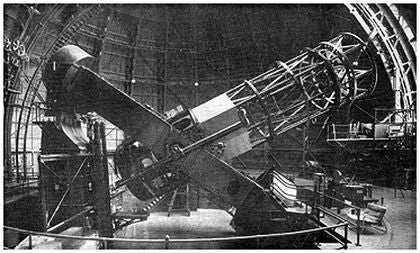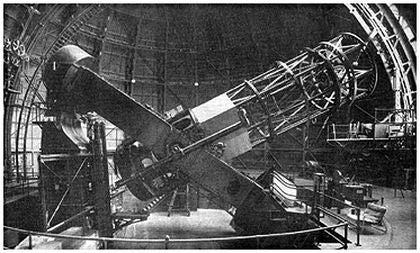Why do astronomers use telescopes? The answer is NOT u201cto make distant things look closeru201d but rather to make fainter things look brighter. In that respect, telescope lenses are very different from camera lenses.

The Hooker Telescope at the Mount Wilson Observatory, as used by Edwin Hubble in the 1920s to investigate “spiral nebulae” that actually turned out to be distant galaxies. Picture courtesy of Mount Wilson Observatory (http://apod.nasa.gov/apod/ap950701.html)
Telescopes are used to view very distant objects so if we want to get a feel for the problems that might be faced then it is useful to start by thinking about a familiar terrestrial photographic situation.
You will probably have noticed that using a telephoto lens to photograph a very distant object, such as a yacht on the horizon, can be quite disappointing because although the lens makes the boat look a bit bigger it’s still fairly small in the picture. This is because the yacht was further away than you probably thought in the first place – and objects that are viewed through astronomical telescopes are even further away than that.
In the case of the yacht, if you had been, say, five times closer to the boat then it would still have looked small enough for you to want to fit a telephoto lens – and the telephoto lens that you fitted from even further away simply took you to that point. So it is with telescopes, except that regardless of how much closer you get (optically) to a distant object, it’s always going to look disappointingly small.
Early astronomers tended to take this approach and probably believed that if they could only build a telescope with a long enough focal length then all the mysteries of the Universe would be revealed.
Sadly, stars that are no more than pin-points of light will always look like pin-points of light regardless of the telescope through which they are viewed. So if they are always going to be pin-points, what’s the use of an astronomical telescope?
The first answer is that some objects – our moon and the planets – aren’t pin-points so a telescope will show more detail than can be seen with the naked eye. The second answer harks back to the earlier comment about making faint objects brighter.
If you go into a dimly lit room then your pupils will dilate to collect more light so that you can see more clearly than would otherwise be the case; similarly, when you take pictures under poorer lighting you could use a wider aperture to make the exposure. And it is the same with telescopes.
In effect, you can think of a telescope as a “light funnel” that collects the light arriving at its wide front aperture and concentrates this light so that it can be viewed by looking into the eyepiece.
Without telescopes, humans on Earth would not be able to see anything in the night sky that is below a certain brightness level but by using a telescope it is possible to see much dimmer objects. These objects might either be dim because they emit very little light or they might be dim because they are further away. In both cases, such objects would have remained invisible were it not for the invention of the astronomical telescope.





